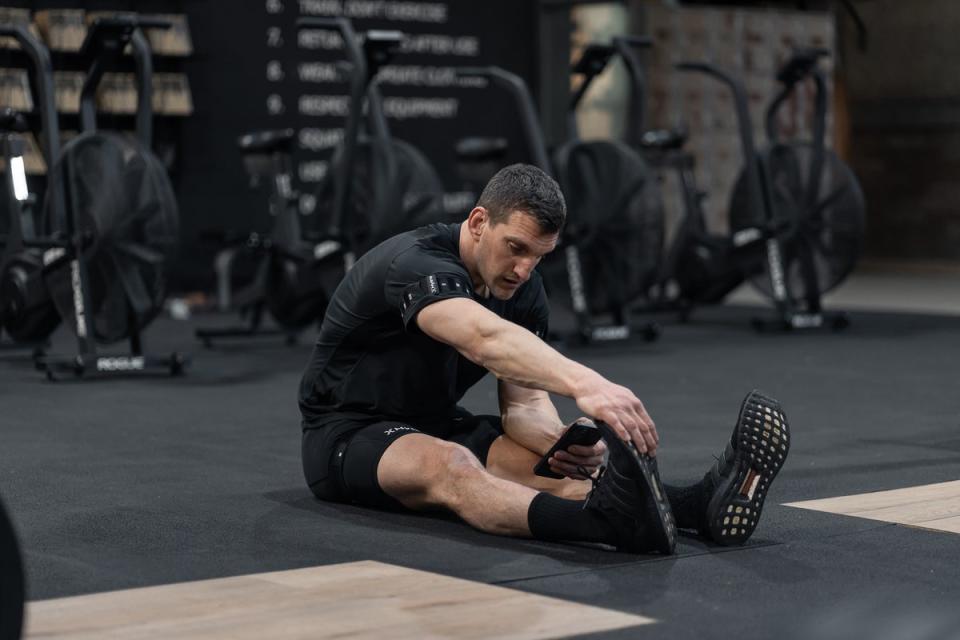Is Blood Flow Restriction training as scary as it sounds?

Deliberately stemming the blood flow to specific parts of the body might sound both dangerous and unpleasant to the uninitiated. However, it is an increasingly popular fitness technique employed by everyone from recreational gym bunnies to world-class athletes. Here, we look at the pros and cons of Blood Flow Restriction training.
What is Blood Flow Restriction training?
Essentially a workout technique, BFR training restricts the blood flow during low-intensity exercise. The result is similar to high-intensity training. It is practised using bands (placed tightly around limbs, typically just under the shoulder or just below the hip, which look a bit like blood pressure cuffs and act like a tourniquet — stemming blood flow to specific muscles for set periods of time during training sessions. This basically limits the amount of oxygen the muscles receive and forces them to work harder.
The idea is that this is an optimal way to enhance and promote the size, and strength, of muscle mass.

Is this a new fad?
Far from it, actually. It was actually first developed in the 1960s by Yoshiaki Sato, a weightlifting doctor in Japan who employed it for training and recovery. His company Kaatsu makes BRF devices and creates specialised training programmes.
OK, who’s doing it?
Once used by only world-class athletes including football and rugby players, swimmers and marathon runners, BFR has become popular with A-listers — actors Mark Wahlberg and Tracee Ellis Ross are said to be fans. Now, it is increasingly in demand with regular gym-goers: you know, the people with bands around the tops of their limbs while they train. That’s BFR in action.
However, it’s also used for general wellbeing and pain management by physiotherapists.
“It can be a benefit to anyone from an Olympic-standard, elite athlete, to an elderly individual in a care home, to people managing chronic pain day to day, or people who just want to recover and improve performance,” says Dr Warren Bradley, founder and chief technical officer at Hytro, the first BFR wearable designed specifically to improve sports performance.
Does Blood Flow Restrictive training hurt?
“That depends on what your pain tolerance is like,” says celebrity personal trainer, Dan Roberts, Online Strength and Conditioning Coach. “It feels a bit weird, but the biggest variable as with all exercise is the intensity of the user. So, my answer is yes, it hurts a bit if you do it properly, but so should all strength exercise.
“If you run regularly and also do regular weight training, then you’ll be fine.”
What are the benefits of Blood Flow Restrictive training?
Despite working at only a low intensity, the muscles will perform as if they have been subject to more intense training — but with a reduced risk of injury. For example, you can lift much lighter weights but, thanks to a BFR band, get the same result.
But it’s not only a weightlifting aid. In fact, BFR bands can be used in any training routine, from treadmill to tricep dip.
“You can use it for a whole session or you can include it within your regular workouts,” explains Josh Davies, a personal trainer at Aimee Victoria Long. “For example, you could perform goblet squats using BFR before moving into regular barbell squats without BFR.”
Using BFR techniques regularly can see muscle growth within around a month and enhanced strength gains within around 10 weeks.
It’s also ideal for those with packed schedules as the sessions are so short.
“It is recommended not to do more than 20 minutes of blood flow restriction work at one time,” says Davies. “You only need to perform one exercise per body part for blood flow restriction if you are doing a full body workout.”
But is also helps with injury. Dr Bradley lists accelerated recovery, pain modulation in those suffering with chronic pain and tendinopathies in joints as only some of the ways it can aid healing.

What are the downsides?
There are a few — including the risk of fainting and dizziness, plus temporary numbness or pain on the limb which has experienced blood restriction.
Dr Bradley points out that while you don’t need to be in good shape to try BFR, it is important to risk assess.
“You will need to check any potential risks, for example, severe hypertension or a family history of - or current — blood clots, typically things associated with higher risk when you exercise anyway,” he says. “So there’s no additional risks in doing BFR versus normal exercise — the contraindications [conditions that serve as a reason not to take a certain medical treatment due to the harm that it would cause the patient] are the same.”
What we do know for sure is that BFR is not suitable for people with cardiovascular conditions.
Where can you try Blood Flow Restrictive training?
Do not, and this cannot be stressed enough, try BFR on your own without having had a few sessions with a trained professional first. This might be a certified personal trainer, doctor or physiotherapist.
It is so important that it is done correctly using approved equipment; don’t even think about using 100 denier tights and guestimating where to place them.
After you have been initiated by an expert and have some proper BFR bands, you can start to use them on your own at home or in the gym.
Both Davies and Dr Bradley recommend doing plenty of research before beginning BFR training to clarify what you want to achieve and gain a deeper understanding of what’s involved.

What band to use?
Some bands need to be tightened manually and some are tightened by air pressure that inflates them — the former are less expensive. Elastic bands are available but tend not to be widely recommended as they expand and contract as you move — which means the blood flow restriction you’re going for is significantly compromised. Instead, look for a ‘rigid’ band.
There are plenty on the market which have stellar credentials when it comes to performance and safety including versions by Kaatsu, Myomaster and Hytro.
A word of warning from Dan Roberts, though: “Some gym goers get overexcited by BFT and put the cuffs on way too tight... this will restrict arterial flow which is bad as it will make your muscles not work at all. You should aim for a 7/10 tightness and when in doubt, go softer. (Studies have shown that 40 per cent restriction gets the same benefits as 80 per cent).”

 Yahoo Sport
Yahoo Sport 





































